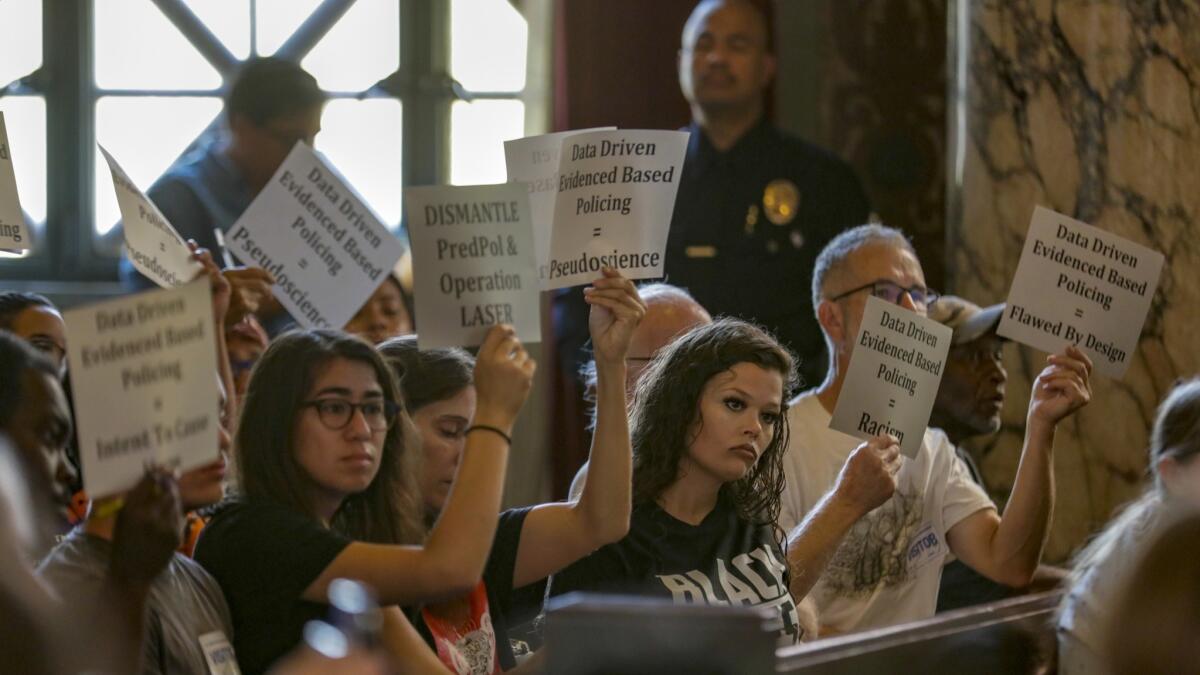LAPD to scrap some crime data programs after criticism

Los Angeles Police Chief Michel Moore plans to scrap a controversial program that uses data to identify individuals who are most likely to commit violent crimes, bowing to criticism included in an audit and by privacy groups.
In a five-page memo sent Friday to the Police Commission, the civilian panel that oversees the LAPD, Moore detailed a host of changes in response to a 52-page audit by Inspector General Mark Smith.
Smith found that the department’s data analysis programs lacked oversight and that officers used inconsistent criteria to label people as “chronic offenders.” Smith also couldn’t determine the overall effectiveness of a geographic component that tried to pinpoint the location of some property crimes.
Moore told commissioners the department will not use programs that fail to produce results and will strive to “identify new or emerging ideas that hold promise.”
“Crime reduction strategies are never static,” wrote Moore, who is scheduled to present an oral report to the commission on Tuesday. “We will continue to learn and evolve in our work.”
For years, critics have lambasted the data-driven programs — which use search tools and point scores — saying statistics tilt toward racial bias and result in heavier policing of black and Latino communities. After the “chronic offender” lists created an uproar among civil liberties and privacy groups, the LAPD suspended that tool in August.
Andrew Ferguson, a law professor at the University of the District of Columbia who studies policing data and wrote a book on the topic, credited Smith’s audit for exposing problems. Police leaders, he said, need to be transparent if they want to build community trust and accountability around data programs.
“You have to have the courage to go to the community to tell them how you’re using it and if it is broken,” said Ferguson, who called for annual audits of the programs. “If they do that, they’re going to be leaders” in the country.
Smith’s audit focused on several tools.
For violent crime, the department draws “LASER” zones devised by a human crime analyst, not a computer — to identify crime hot spots and where to focus more officers.
Many of the department’s divisions also used data to compile lists or “bulletins” of people calculated to be among the top 12 “chronic offenders.” The program assigned points to people based on prior criminal histories, such as arrest records, gang affiliation, probation and parole status and recent police contacts.
Smith found that 44% of the so-called chronic offenders had either zero or one arrest for violent crimes. About half had no arrest for gun-related crimes. Others were in custody or had been arrested for only nonviolent crimes.
Officers will now rely more on old-school tactics, using physical descriptions of those suspected in reported crimes. They will also focus more closely on perpetrators recently released from custody and those who have committed similar crimes in the past, the memo stated.
Moore also plans to increase oversight by developing “precision policing” manuals tailored to each of the agency’s four geographic commands. The manuals, which are expected to be completed this summer, will incorporate the inspector general’s recommendations. The four area commands will provide a “centralized model of oversight from the Office of Operations,” Moore wrote.
The inspector general’s audit also found discrepancies with a location-based tool, called PredPol, shorthand for predictive policing.
The software program is designed to predict where and when crimes will likely occur over the next 12 hours and where to target officers. The software’s algorithm examines 10 years of crime data, including the types of crimes, dates, locations and times.
But Smith found that some factors, for example, the size of the crime zones and presence of police facilities, skewed the data.
The department is in the process of developing “smaller micro hot spots, approximately 500 feet by 500 feet.” It also plans to work with the vendor to exclude the crimes reported by people at police stations, Moore wrote.
“It has been noted that a location-based strategy of identifying patterns and series of crime trends at specific locations, corridors or neighborhoods are a proven crime strategy.” Moore wrote.
A recent study from New York University School of Law and NYU’s AI Now Institute examined data programs in troubled police departments in Chicago, New Orleans and Maricopa County, Ariz.
The study concluded that “dirty data” lead to biased policing and unlawful predictions. Those policies repeatedly send officers to the same neighborhoods, regardless of the crimes committed, the study found.
Rashida Richardson, director of policy research at the AI Now Institute and a co-author of the report, said Smith’s findings mirrored suspicions that police target specific communities.
“This shows a larger policing problem,” she said. “None of this is standardized. A lot of this system is one-sided.”
LAPD Officer Hannu Tarjamo, a director at the Los Angeles Police Protective League, said the data programs can be helpful, but they also distract officers from police work. Community policing, he said, is done best when officers learn areas and know who commits the crimes.
The league “has faith that (Moore) will do the right thing” with the programs, Tarjamo said.
Community activist Najee Ali said residents expect improvements in the wake of the audit. Ali said he welcomes future data audits and changes to problematic programs.
“We hope Chief Moore will continue to listen and value our input,” Ali said.
More to Read
Sign up for Essential California
The most important California stories and recommendations in your inbox every morning.
You may occasionally receive promotional content from the Los Angeles Times.











